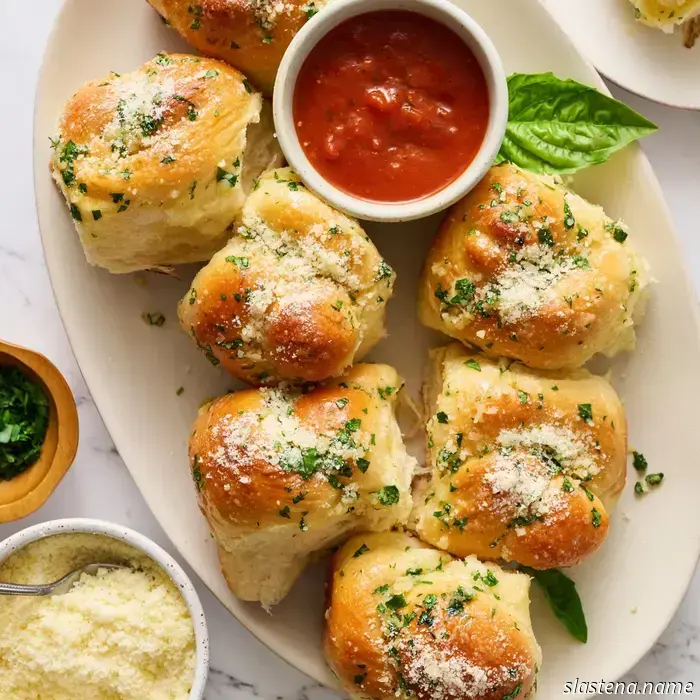
Garlic Knot Rolls
Tessa’s Recipe Overview
**Taste:** Buttery and garlicky excellence with a touch of herbal freshness from parsley, topped with a dusting of fresh Parmesan cheese. Pure bliss!
**Texture:** The highlight! These garlic knots are incredibly soft, fluffy, and delightful to eat.
**Ease:** While yeasted doughs may appear daunting, I assure you this method is much simpler than it appears.
**Why You’ll Enjoy This Recipe:** These homemade Garlic Knots are on par with the finest restaurant versions but even superior since they are made fresh in your kitchen. They’re soft, drenched in garlicky butter, and so addictive that you’ll wish you had prepared a double batch!
This post may contain affiliate links. Please refer to our disclosure policy.
Pillowy-soft and filled with the ideal amount of garlic, these Garlic Knot Rolls are utterly irresistible. I’m truly excited to share this recipe with you!
The inspiration for these knots came from a pizzeria in Phoenix that has unfortunately closed. Their version was wonderfully dreamy — soft and fluffy with just the right amount of garlic to leave you craving more, without overwhelming you. I immediately set out to recreate them at home.
Most garlic knots are simply made from pizza dough and tend to be lackluster.
**Free Baking Science Mini-Course!**
From cookies that spread too much to undercooked brownies, this FREE 5-day Baking Science course will help you overcome common baking issues and create bakery-quality treats every time.
I’m pleased to say that my recipe is anything but dull. These are the softest, fluffiest, and most flavorful restaurant-quality garlic knots EVER. The best thing? They are approachable enough for beginner bakers yet impressive enough to share with family and friends.
One bite, and your loved ones will be absolutely hooked.
They’re like little pillows of bread enveloped in garlicky buttery delight. Dangerously delicious. Seriously, don't anticipate any leftovers!
Serve these Homemade Garlic Knot Rolls for Easter dinner or Thanksgiving, alongside my favorite Cheesy Green Bean Casserole, my crowd-favorite Sweet Potato Casserole, or with my Pot Pie Soup for a cozy evening.
**A Bit of Science**
**How to Make Garlic Knot Rolls**
**Bread Flour is Essential!**
For the best texture, I strongly advise using bread flour instead of all-purpose flour. Bread flour contains more protein, resulting in taller, fluffier, and slightly chewy Garlic Knots. I prefer King Arthur Flour's Bread Flour.
If you opt for all-purpose flour, your Garlic Knot Rolls may require additional kneading time, may not rise as high, and may lack the same pillowy texture.
**Measuring Tip:** Always measure your flour accurately to avoid dense rolls. A digital kitchen scale is the most precise tool, but if you don't have one, use the spoon-and-level method to prevent accidental over-measuring.
**The Yeast**
For convenience and dependability, I suggest using instant yeast (also known as rapid-rise or quick-rise yeast). Simply mix it directly with the ingredients—no need for separate proofing! Instant yeast is typically available at most grocery stores or can be purchased online.
If you don’t have instant yeast, simply substitute the same amount of active dry yeast. Combine it with the warm butter and milk once the mixture reaches about 100°F (be careful—if it’s too hot, it will kill the yeast!). Add a pinch of sugar, then let it sit until bubbly, which takes about 5 minutes, before proceeding with the recipe.
**The Sugar**
Although this dough isn’t sweet, a bit of sugar is vital! It activates the yeast, softens the dough, and results in a more flavorful roll. Don't omit the sugar! It’s critical for the dough's structure and rise.
**The Eggs**
You’ll need three large eggs: two are for the dough to add richness and structure, while one is for the egg wash to create a lovely golden brown, slightly crisp exterior.
**Egg Size Matters!** Large eggs weigh around 56 grams in their shells—using eggs that are too large or too small can affect the dough’s texture.
**The Milk**
For the best flavor and texture, opt for whole milk. I haven’t tried non-dairy alternatives.
**How to Knead Bread Dough**
This dough is enriched with additional fat and sugar, which means it takes a bit longer to knead than a leaner dough. A stand mixer fitted with a dough hook makes the process much simpler. If you don’t own a stand mixer, you can learn how to knead by hand.
Knead until the dough is soft and smooth but slightly tacky. It should be stretchy enough to pass the windowpane test: take a piece of dough and stretch it between your hands until it forms a thin sheet. Hold it up to a light source, and it should allow light to pass through without tearing excessively.
If your












Other articles
Garlic Knot Rolls
Soft and fluffy, these Garlic Knot Rolls are filled with delicious garlic butter flavor, making them completely irresistible.
